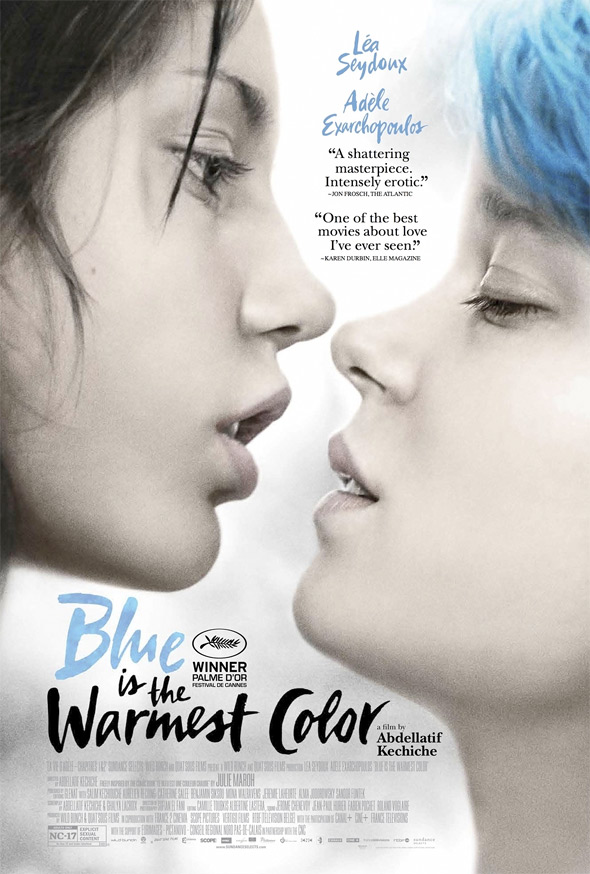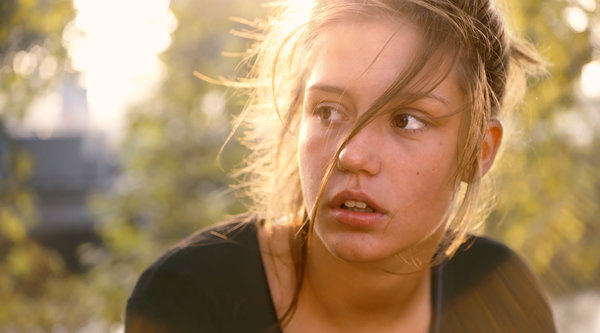Genre: Drama/Love Story/French
Premise: A high school girl becomes involved with an older artist and the two soon find themselves falling in love.
About: Okay, so this movie has received a lot more publicity than your typical French import for a couple of reasons. First, there’s a lot of graphic lesbian sex in it (have I got your attention, guys?). And second, the actresses who played the leads are now saying that they were forced to do a lot of things sexually that they weren’t comfortable with. The film won the prestigious Palme D’or at the Cannes film festival, and that’s when the heavy scrutiny began. Director Abdellatif Kenhiche, who was at first defiant against his actresses and their accusations of him, has done an about-face, pretty much shutting down when asked about the controversy. His most recent interviews imply that he realizes he may have gone too far and it may have even affected his desire to direct again.
Writers: Abdellatif Kechiche & Ghalia Lacroix (based on the comic book, “Le Bleu est une couleur chaude” by Julie Maroh)
Details: 186 minutes long
Hey, a French film about a young woman’s sexual awakening. Where have I seen this before? Oh yeah, that’s EVERY SINGLE FRENCH MOVIE EVER. Didn’t we see it as far back as Seinfeld? When the Seinfeld crew tried to go see Rochelle, Rochelle?
Okay, so maybe it’s not EVERY French movie. I’m guessing there are only a handful of French genres they can market over here in the States, and “sex between young women” is one of them. There are probably tons of more diverse French films we’ll never see because distributors know there’s no way they can do well in the ultra-competitive American marketplace.
As far as this film, I’ll be the first to admit that the only reason I went to see it was because of the controversy behind the sex scenes. I had to see myself just how far they supposedly went, and also if I could detect any clear discomfort on the actresses’ part or see if they was forced into something they didn’t want to do. I wanted to make the call myself.
Here’s the funny thing about what happened though. There was so much damn sex in this movie, that after awhile, the shock value wore off. What you realize is that, along the way, you’ve been pulled into this relationship, a relationship authentically constructed and universal enough to make you see yourself in it, and in that sense, care about the fate of these two girls, even if that fate took 186 minutes to get to!
17 year old Adele is in high school. She’s a pleasant enough girl, but you get the feeling she’s uncomfortable in her surroundings (and, in many ways, her own skin).
As is the case in most high schools, Adele’s friends are peer-pressuring her into doing things she doesn’t want to do, particularly have sex with a hot guy who’s into her. Adele eventually does go out with the guy and DOES have sex with him, but there’s clearly something missing from the experience. She needs more.
After an unexpected kiss with a female friend, Adele becomes obsessed with women, and finds herself at a lesbian bar one night, where she meets the mysterious older Emma, a blue-haired maven who’s as confident as Adele is timid.
The two immediately hit it off, spend all their time together, and start falling in love, as is on display every night with their extremely passionate love-making.
A year passes and Adele is now out of school (teaching pre-school) getting her shit together. Her relationship seems to be going well also, as she’s helping Emma (who’s an artist) get ready for a big art showing. The problem with Adele is that she can’t shake the feeling that she’s doing something wrong by being with a woman. It’s a subtle feeling, but intense enough that she ends up cheating on Emma with a man (partly brought on by a suspicion that Emma may be cheating on her).
Emma finds out and the entire relationship unravels. Emma kicks Adele out and Adele is completely lost. A couple of years go by and, still, Adele misses Emma. She tries her best to reconcile but Emma’s moved on. Poor Adele is left with an uncertain future, which she now knows will never include the love of her life. Fin.
So why is it that this movie, despite ignoring most of the screenwriting principles I promote on this site, still worked? That’s a great question. To start, you have to understand that this is a relationship movie. With relationship movies (which includes romantic comedies), there isn’t always a goal. The story’s intrigue rests more on “What’s going to happen between these two people?” The movie only works if you care about the answer to that question. And you only care about the answer to that question if you a) like the lead, b) like the romantic interest, and c) want to see them end up together.
So the rules are a little different (from the typical GSU model). And I think “Blue” succeeded on all three of these fronts. I mean, the acting in the movie was amazing, but if the story was written with the same specificity as it was acted, I think it would’ve worked just as well on the page.
But there were a few other reasons why it worked. Conflict conflict conflict conflict and conflict. If you’re going to write a slow story (whatever the genre is), it must be infused with conflict. Because you have to remember – we don’t have anything STORY-RELATED to look forward to. We don’t have Indiana Jones trying to get that Ark. We don’t have the Pacific Rim robots trying to stop those monsters. We don’t have little miss sunshine trying to get to that beauty pageant in time.
For that reason, you have to use OTHER tools to keep the reader/viewer interested. And conflict is the most effective of these tools. And in this case, it starts with INNER CONFLICT. Adele is unsure if she wants men or women. We see her battling with this dilemma throughout the first 40 minutes of the movie. When she finally gets a woman, there’s a part of her that’s still nervous about whether she should be with her. We see that in scenes like when she brings Emma over for a family dinner. She can’t tell her parents the truth about Emma. She’s too ashamed. And then when Emma breaks up with her, all Adele can think about is that she’s not happy without her. In all of these instances, Adele is battling some sort of inner conflict.
But there’s plenty of external conflict as well. From getting into fights with her schoolmates about her sexuality to trying to start a relationship with the friend who kissed her (who then rejects her) to hiding from her parents that she’s dating Emma to being underage and dating Emma to being pulled by this man at work to eventually cheating on Emma to trying to get Emma back.
Despite some of the early scenes where Emma and Adele were in the honeymoon period, there was conflict in every scene. You never felt 100% comfortable during “Blue.” You always felt like something was unresolved, and that’s why you needed to keep watching. You had to see that resolution.
And, you know, I was surprised by just how many plot developments they packed in here also. Usually, in these relationship or coming of age movies, whether they be American indies or foreign films, it takes FOREVER for anything to happen. But stuff kept happening here all the way through. Adele is pushed to go out with a guy. She does. It doesn’t work out. She kisses a girl. She’s excited and pursues her. She’s rejected. She hangs out at a gay club. She meets a girl. She starts dating her. She meets Emma’s parents. Emma meets her parents. She helps Emma prep her art showing. A new woman is introduced into Emma’s work life who Adele is jealous of. Adele cheats on Emma. I always felt like things were HAPPENING, that stuff was DEVELOPING here. And that’s why it never got boring.
And you know, the thing that this script is getting hammered for, the over-the-top sex – was actually necessary. Because it showed how attached these two were. The passion in their sex showed how much they loved each other. And I’m not sure I would’ve known how much they were in love had that not been shown. I mean I wouldn’t have felt Adele’s desperation to get Emma back in the final third of the film had I not seen that passion.
After I walked out of “Blue,” I had to ask myself a tough question. I’d enjoyed the film. Yet I constantly tell writers not to write a film like this. Would I have to reevaluate that stance? Should I do a 180 and start preaching, “Go forth and write 180 page relationship movies if that’s what you want to write!”
After giving it some consideration, the answer is still no. I have to remember that I’m teaching people how to break into Hollywood, not Pariswood. And in Hollywood, creating marketable material with complex characters and a story that moves is still the easiest way to break through. If you want to write the next “Blue is the Warmest Color,” because it’s a story you NEED to tell and you won’t be able to live your life unless you write it, by all means, don’t let me or anyone else stop you. Sometimes passion is the best storyteller, so there’s a possibility it comes out great. Just know that, at the end of the day, you’re trying to sell a product to someone who will be trying to sell that product all the way up the Hollywood ladder. As long as you know that this process becomes infinitely harder when you try to sell the entertainment business the kind of movies it doesn’t like to make, go for it. I’m not going to hold it against you if you take a chance. Just make sure what you write is great because it will need to be!
[ ] what the hell did I just watch?
[ ] wasn’t for me
[x] worth the price of admission
[ ] impressive
[ ] genius
What I learned: The Honeymoon Period. Relationship movies (including romantic comedies) are all about conflict. They’re about your protagonist being unable to find someone (conflict), to experiencing everyday life obstacles (conflict) and then when they find someone, it’s about things affecting that relationship, like cheating (conflict), everyday relationship problems (conflict), work (conflict), other people (conflict). Your relationship films should be PACKED with conflict. The one time in the script, however, where it’s okay to be conflict-free, is the “Honeymoon Period.” When your characters first get together and start hanging out, it’s okay for them to have fun (this can last anywhere from 3-8 scenes). But sooner or later, conflict should start creeping into that relationship, or we’ll get bored.




